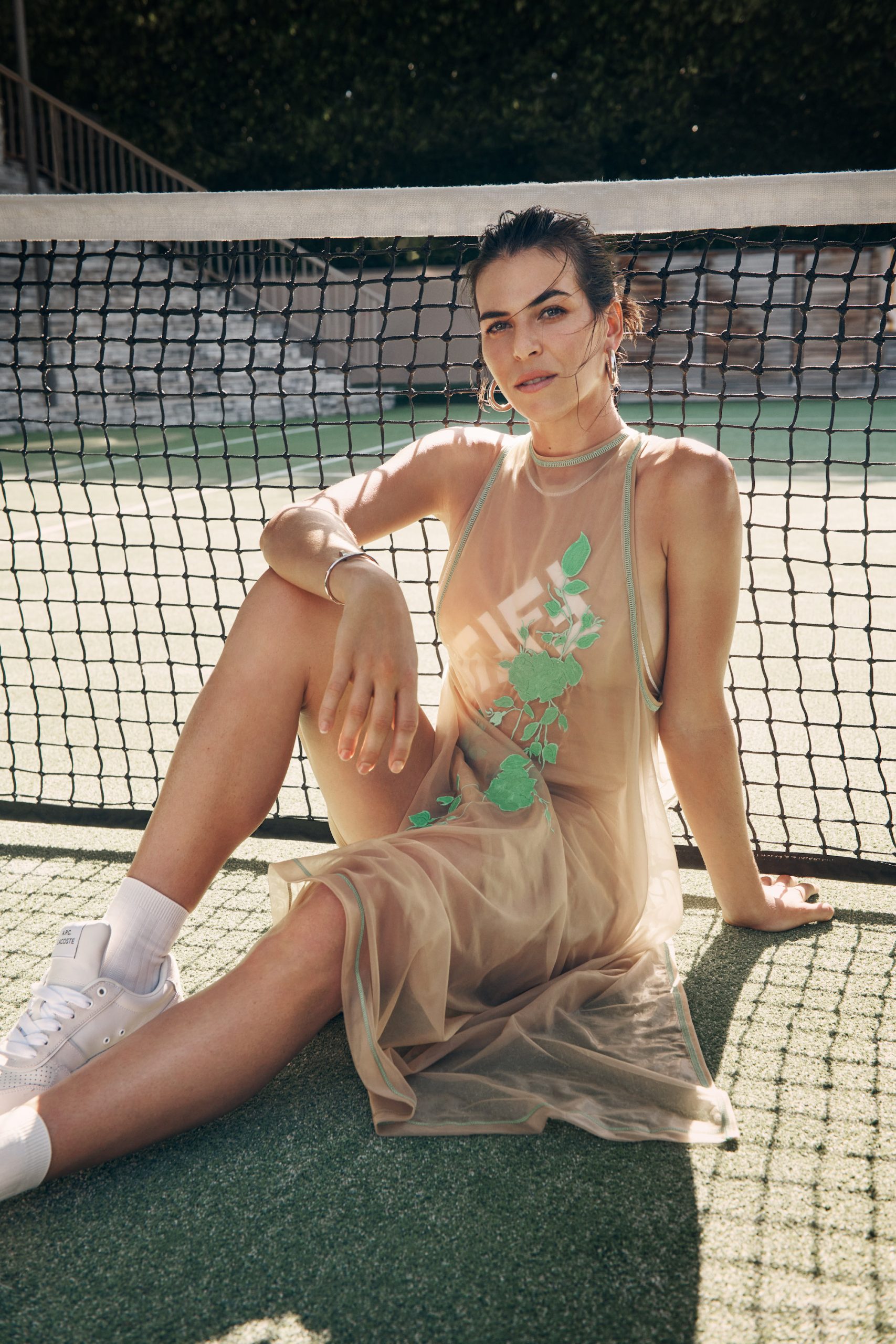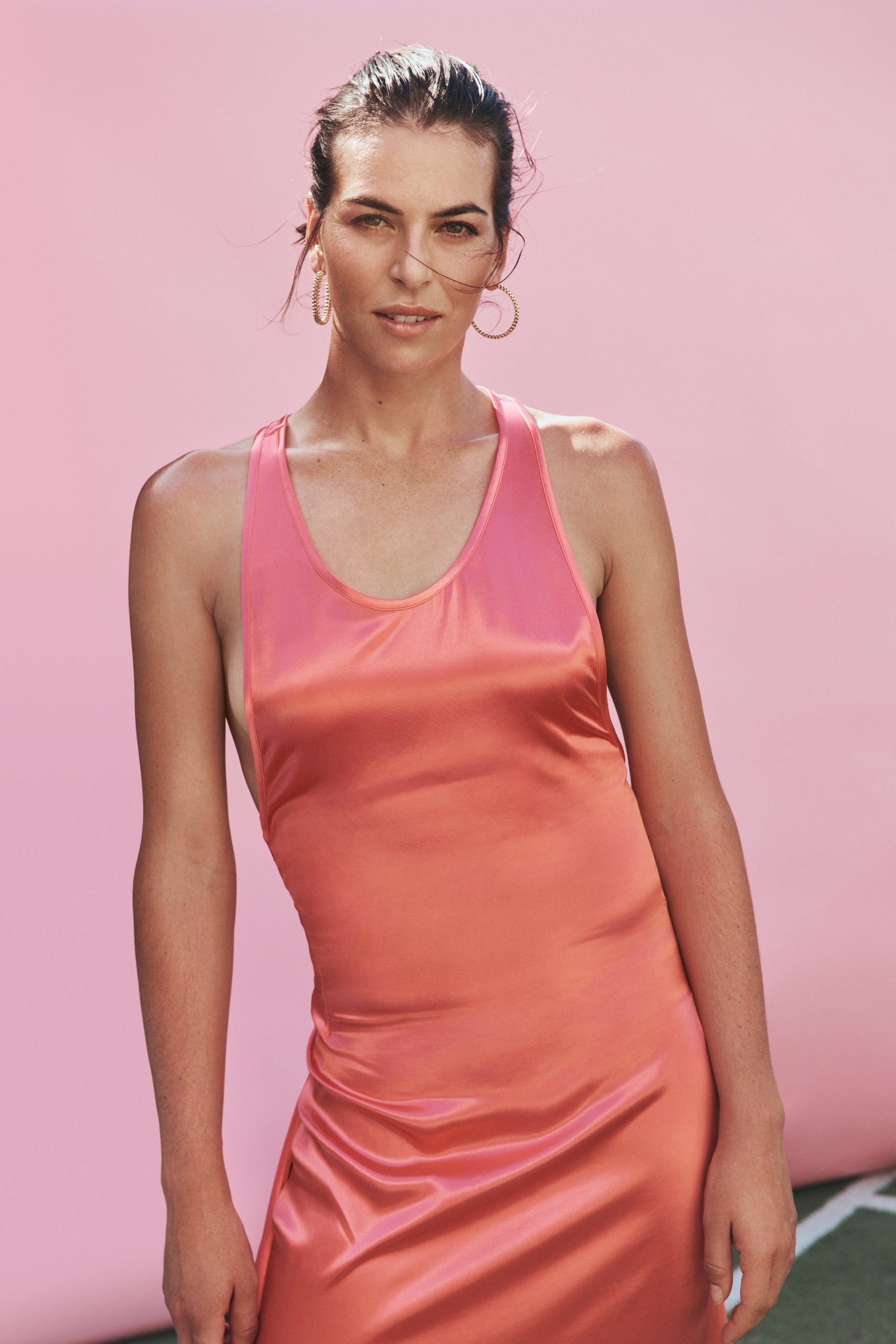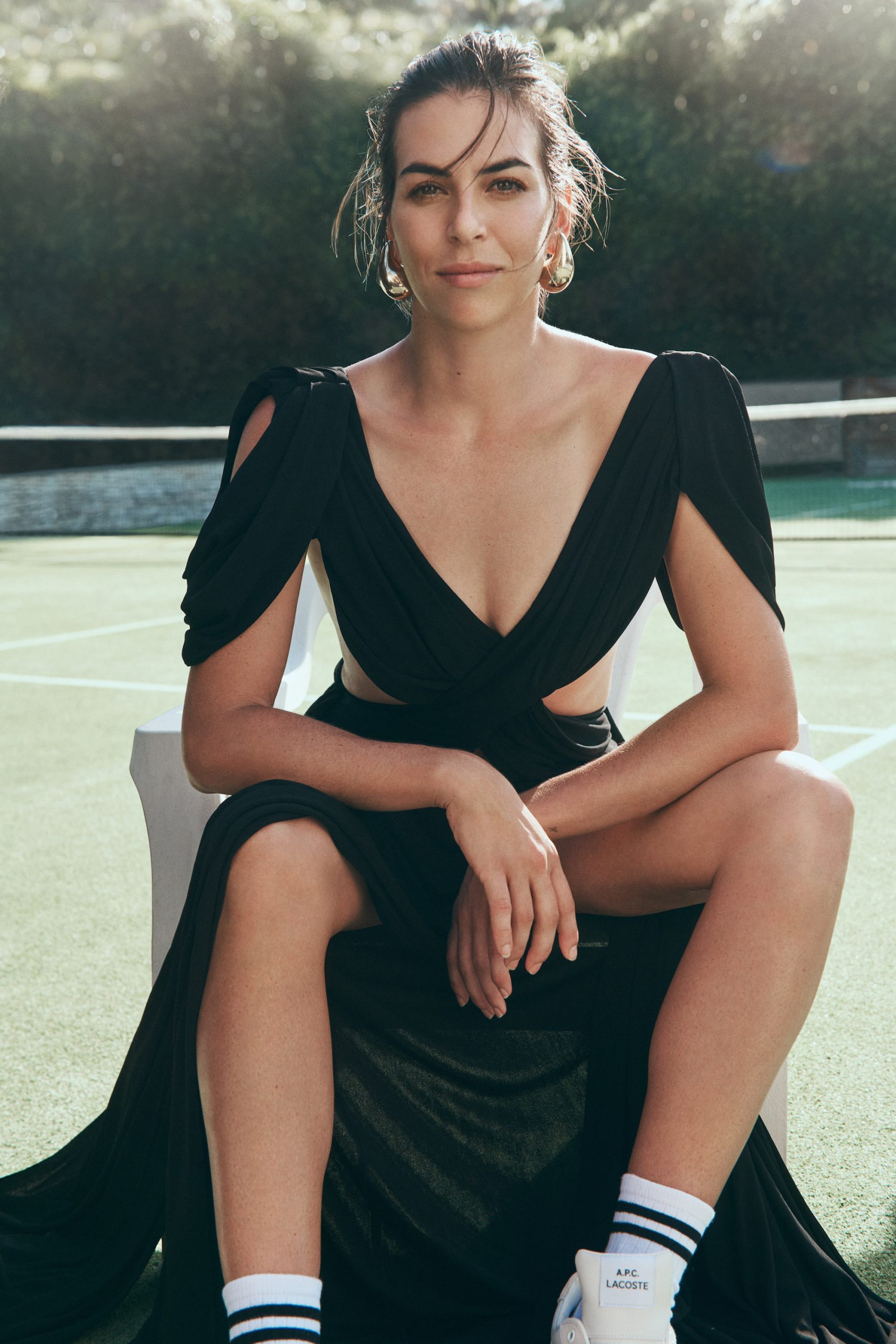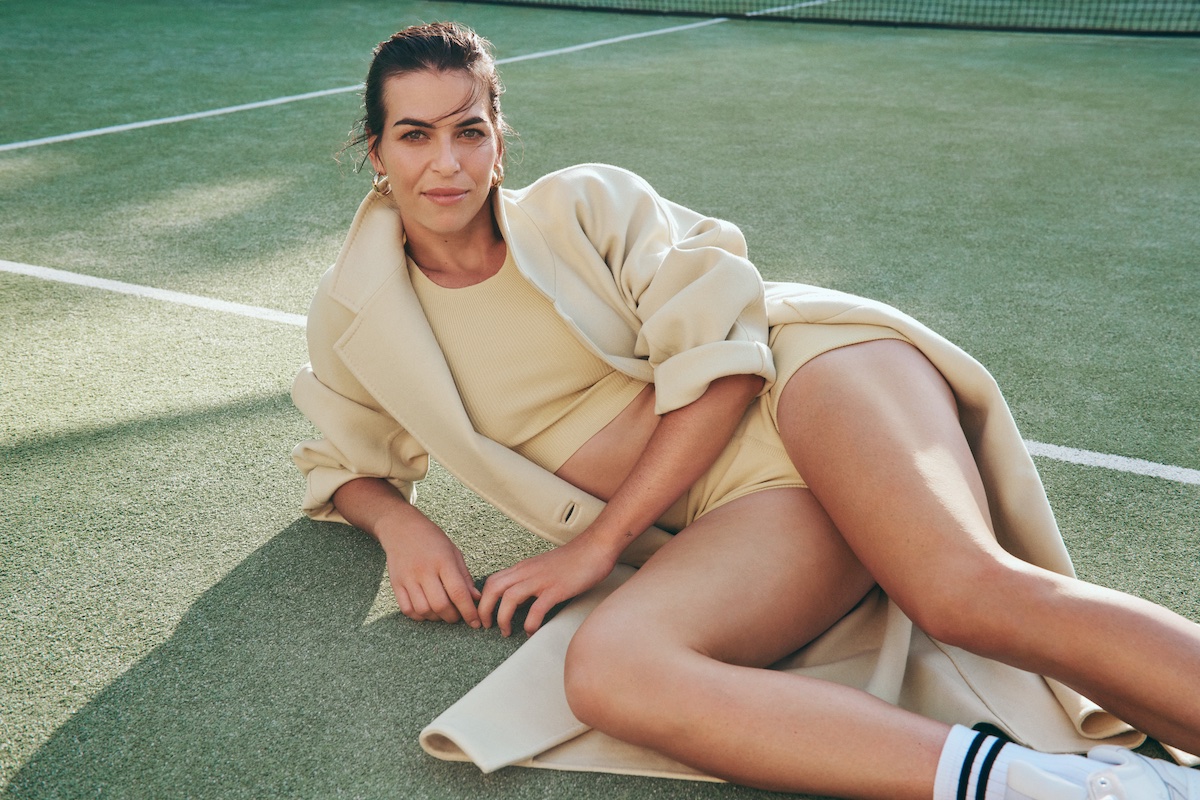On the final day of any golfing tournament Tiger Woods always wears red. It’s a tradition he’s maintained since his junior days at Stanford University, and one he insists has aided his biggest wins. Similarly, the cricketer Steve Waugh was never seen batting without his lucky red handkerchief peeking out of his left pocket, while the 23-time Grand Slam winner Serena Williams reportedly wore the same pair of socks for full tournament runs throughout her career.
Many athletes commit to superstitions or pre-game rituals, leaning on talismans or divine intervention for performance enhancement. Ajla (pronounced like “Isla”) Tomljanović is not one of them — though not for lack of trying. During a winning streak at the 2014 French Open, the 72nd-ranked Tomljanović dined at a nearby Thai restaurant, a questionable choice that now makes her laugh.
“I would never eat Thai, it’s so heavy,” she says. “But I was 21; I was invincible.” Upon her return to Roland-Garros the following year, Tomljanović leaned into the cuisine’s supernatural potential and insisted on eating Thai. She lost her next match. “I was like, ‘This is so stupid,’ ” she says on a Zoom call from her home in Boca Raton, Florida. “I just know that has no impact on how I’ll do, so my mind just doesn’t go there.”
Harnessing the power of the mind, both on and off the court, is something Tomljanović has been working on a lot over the past few years, and it’s a skill she needs this week. At the time of writing, it’s summer in Australia, a time defined by bushfires (sometimes), school holidays (always) and, for two sweltering weeks, a national fixation with tennis, which takes hold as the sport’s top competitors stake out Melbourne for the Australian Open.
This year, Tomljanović was primed to succeed. The Open’s reigning female champ, Ash Barty, shocked the world last March by announcing her retirement and, in September, Tomljanović made headlines by playing the villain in Williams’ swan song, defeating the GOAT in her final match at the US Open. The stage was set for the nation’s new golden girl to step into her own.
But a lingering injury to her left knee was causing concern. In late December, Tomljanović withdrew from a United Cup match with Great Britain’s Harriet Dart then, in early January, she announced that she was bowing out of the Adelaide International. Fans remained hopeful for a home Grand Slam appearance, but a two-word tweet posted a few days before she was due to compete confirmed the worst: “I’m sorry.” An extended statement released via Tomljanović’s Twitter and Instagram accounts explained she wasn’t in a state to play (she’s since undergone minor surgery and will be off the court for several months).
“You never learn, really, to cope with these moments,” she says of leaving the tournament to return to Florida.
“To miss out on your home Slam and then have to watch from the sidelines could be the most painful thing an athlete can go through.” She smiles. “Okay, maybe that’s dramatic,” she says, “but it just feels like that right now.”
“Cruel” is not a word often conjured in reference to tennis. The manicured courts, strict dress codes and lack of helmets, mouthguards and player-on-player contact paint the pastime with an air of aristocratic refinement. But the game can be lonely, quiet and psychologically vicious (in his 2009 book, “Open”, the former world No. 1 Andre Agassi likens the game to solitary confinement). Players are not afforded mid-game coaching and, barring doubles, there is no reassuring banter among teammates.
For those who aren’t Williams, Federer, Nadal or Djokovic, chances are the losses severely outnumber the wins and, unlike other sports, players aren’t drafted or contracted to teams, so for many it is a job without security and income. Ranking points expire each year, meaning each game of each tournament becomes a defence of one’s place on the ladder. An ill-timed injury can prove fatal to a career. And when a player finishes their last set? “No matter who retires, tennis goes on,” says Tomljanović. “And that’s almost the cruellest part of the sport: the train doesn’t stop for anyone.” Skills will take you far, but this game also requires grit.

For Tomljanović, who was born in Zagreb, Croatia, tennis was not exactly a choice, but rather something she arrived at through a process of elimination. Her father, Ratko, was a professional handball player and the captain of the national Croatian team. She recalls watching him and her mother, Emina, playing tennis with friends and says that her older sister, Hana, took lessons as a child.
Competitive from the outset and eager to achieve success like her father, Tomljanović was always interested in sports, but never teams. “When I was doing something, I wanted to do it great,” she says. “And I felt like sharing the court with eight [or] nine other kids was completely useless for me.” She picked up a racquet at six and begged her parents for private coaching.
Tennis was a perfect fit for Tomljanović’s talent and temperament. She immediately showed promise with power and a knack for strategy, but most striking was her resolve. She relished performing on her one-woman island and was happy to shoulder her wins and losses alone. At age 12, she was signed by the agency IMG Tennis and soon after — whole family in tow — she relocated to South Florida to attend an elite training facility co-founded by the tennis great Chris Evert, who is now a mentor and friend.
For new fans, Tomljanović’s claim to the title of Australia’s top female tennis star might be perplexing. With Croatian roots and a stateside base, she has yet to spend a prolonged period of time Down Under and her accent is an easygoing American-Slavic cocktail completely devoid of Aussie twang. But almost a decade ago, when an opportunity arose to develop her game and play for Australia, she seized it (poaching of this kind is surprisingly common at the top level of the sport). With the support of Tennis Australia, Tomljanović began representing the country in 2014 and was granted citizenship in 2018.
Jelena Dokic, a fellow Croatian-born Australian player, has followed Tomljanović’s game closely over the years. “She’s very technically sound, very well produced,” says the now-retired player, who was once ranked fourth in the world. “There are a lot of layers to her game and a lot of variety. I love to watch her play, not just [for] the mentality that she has, which is to be an aggressive player, but her strokes are beautifully produced.”
Even so, the formidable baseliner with the steely on-court demeanour and wide off-court smile always seemed to be hovering at the fringe of deliverance — waiting, waiting to reach the heights her talent teased in her youth. A string of injuries proved challenging, with a torn tendon in her shoulder sidelining her for an extended stretch in 2016. “We put our bodies through so much over the years,” she says. “They break down sometimes and you’ve got to just give it time to go back to normal.”
thletic achievement is rarely the result of physical exertion alone. Luck, as established, plays a part for some. But winning is also hitched to an athlete’s state of mind, a fact the public has become increasingly aware of in recent years. In 2021, the Japanese tennis player Naomi Osaka withdrew from the French Open after skipping a post-match media call due to mental health concerns (and copping a fine of about $21,000). “Athletes are humans,” she later wrote in an article for Time. “I do hope that people can relate and understand it’s O.K. to not be O.K., and it’s O.K. to talk about it.”
In gymnastics, the American Olympic gold medallist Simone Biles faced backlash after withdrawing from multiple events at the Tokyo 2020 Summer Olympics due to mental health issues. “To do something that I’ve done forever and just not be able to do it because of everything I’ve gone through is really crazy, because I love this sport so much,” Biles said in an interview on the US television program “Today”. “I don’t think people understand the magnitude of what I go through.”
Tomljanović is candid about her aversion to vulnerability. She admits that in the past her imperturbable on-court disposition belied an unresolved well of fear and nerves — emotions she was scared to express even to her family. “I felt like saying, ‘I’m nervous,’ or ‘I’m scared for this match,’ was weakness,” she says. “So I would keep it in until I got on the court and then all of a sudden I’m exposed there. So many matches early on in my career would overwhelm me to the point where I wasn’t strong enough to change my mindset and get through it.”
The onset of Covid-19 and global stagnancy in 2020 served as a moment of reckoning for Tomljanović, who was growing increasingly dissatisfied with the sport she’d committed her life to. “If I went through the list of everything I have in my life, I should be the happiest girl in the world,” she says. “But for some reason I wasn’t and that’s what was killing me. Covid just triggered everything. I had to stop and be like, ‘Well, this is not making me happy like it should.’
“Sometimes really bad things need to happen for you to take action, and I hate that about me,” she continues. “Sometimes I’ll delay certain things that need to happen. But once I took it head-on, it was a process — and not a fun one. It doesn’t come overnight, it’s a daily thing where you just choose to choose happiness.
Like Osaka, Tomljanović recognised her achievements as an athlete depended on her meeting her needs as a human being, and she has begun working with a psychologist to improve her communication skills. “That’s been huge for my mental health on the court, to just communicate everything I’m feeling,” she says. “And then, obviously, for the long process of just getting better as a human being.”

As Tomljanović’s mental health journey gathered momentum, her public star was also rising. She attended the 2021 Met Gala with her partner at the time, the Italian tennis player Matteo Berrettini (both were dressed by Dolce and Gabbana). And when the producers of Netflix’s successful 2019 docuseries “Formula 1: Drive to Survive” turned their gaze to tennis, Tomljanović and Berrettini were invited to participate.
“In the beginning it’s like, ‘Whoa!’ ” says Tomljanović, her eyes growing cartoonishly wide as she talks of the ever-present cameras. “But you do get used to it.” The two-part series, called “Break Point”, spans a year on the professional circuit (the first half was released in January; part two is expected later this year). She and Berrettini are the focus of the second episode, which follows their 2022 Australian Open bids and presents viewers with a side of Tomljanović she doesn’t often broadcast. “On the court, people will always be like, ‘Oh my gosh, you’re so measured, you’re so calm.’ And I’m thinking, ‘If only you knew,’ ” she says. “I’m feisty. If you spent time with me, there’s a whole different layer.”
“Ajla has always been a player who is very hard on herself,” says Evert in a piece to camera shown early in the episode. “That’s been one of the biggest challenges.” Tense conversations with her team following her round-one loss to Spain’s Paula Badosa demonstrate as much. “I wanted to break every racquet out there,” Tomljanović says, seething as she floats the idea of retirement.
Though she and Berrettini quietly split in the year since filming, Tomljanović has no regrets about letting the public see behind the scenes. “If I could have any year filmed in my life, in my career, it would be 2022, because I love the growth that happened,” she says.
That July, she battled her way into the quarterfinal match at Wimbledon for the second year running. But the achievement was bittersweet: results weren’t included in ranking calculations due to Russian and Belarusian player bans. Had the win counted, she’d have cracked the top 20. September brought Williams’ final US Open match and Tomljanović, ranked 46th at the time, defeated the Czech Republic’s Karolína Muchová and Russia’s Evgeniya Rodina for the chance to face off Williams at her spiritual home: Arthur Ashe Stadium, New York.
Tomljanović was nervous, and with good reason. Not only was she staring down her idol and roughly 24,000 of Williams’ most passionate fans, she’d need to hold her own in what would become ESPN’s most watched match in the network’s 43-year history (peaking at 6.9 million viewers).
Tomljanović is no stranger to anxiety — the difference was that she’d learned to channel it. “You’ll see how many times I say that day that I’m very, very nervous to step on the court,” she says, referring to an upcoming episode of “Break Point”. “It’s almost like the more I said it, the less I felt it.”
From the first serve she was in the zone, hitting big and capitalising on Williams’ errors. But the New York crowd roared for their sweetheart and in an inverse of the David and Goliath parable it occurred to Tomljanović that out there, on her island, she was the antihero of this tale. “To do stuff so well out there for three hours and not get one clap or something, it was surreal. You can’t prepare for that,” she says. The self-described overthinker dug deep to silence her inner monologue. “I detached from the outcome in those moments. I said to myself, ‘Just play the game, don’t play the score.’ ”
Six match points in, Williams sent the ball hurtling into the net. After three hours it was all over. “It was the first time I didn’t hear a cheer,” says Tomljanović. What she heard was “just a loud noise of disappointment, and I understood why”. As Tomljanović watched Williams walk towards the net — “not with a head down, but just not a happy walk” — it sunk in that she’d played a hand in ending the career of her lifelong inspiration.
“That was some of the best tennis I’ve watched in a long time,” says Dokic. “It was definitely the best tennis match that Ajla has ever played; it was perfection.”
In her post-match speech, Tomljanović confessed to the devastated crowd: “I’m feeling really sorry just because I love Serena just as much as you guys do. And what she’s done for me, for the sport of tennis, is incredible.” When we speak, she says, “It was definitely bittersweet.” But she tells me she is proud of her form that day, her training and her mind. And, as ever, tennis goes on.
Those with no interest in the sport were suddenly familiar with the Aussie victor, who played five more tournaments before pressing pause to recover from her knee injury. By then, she’d struck up an endorsement deal with the coconut water giant Cocobella and caught the attention of the Champagne house Piper-Heidsieck, which tapped her to be an Australian Open ambassador. “I love Champagne because I’m big on making wishes,” she says. “Maybe that’s my superstition? Any fountain, or New Year’s Eve or when it’s my birthday, I’m going to have Champagne in my glass and make a wish.” Piper-Heidsieck’s CEO, Benoît Collard, says Tomljanović is a perfect fit because she is “courageous and bold” like the brand and represents “everything we love about the Australian way of life”.
Tomljanović is about to turn 30, has just played her finest season of tennis and, pending recovery, has many years of competition left in her (Williams played her last Grand Slam weeks before her 41st birthday; Federer retired his racquet at the same age). “From a maturity and experience perspective,” says Dokic, “I think she is now really hitting her peak. I believe that she can have another phenomenal year.”
So, if Tomljanović were to picture herself in a decade’s time — Champagne in hand, toasting the previous 10 years — what does she wish to see? “I would love to be at a point, in my late 30s, where I am so content and happy with how my career went,” she says. “Because it’s my biggest fear to finish and have regrets, or just not feel like I gave it everything.
“I would love to have a family and all that,” she continues. “But again, I can’t control these things. I’m a family girl so that would probably make me very happy, but you don’t know where life takes you and that’s the beauty of it. I’m very curious to see what I’m going to cheer for in my late 30s.”
What she knows for certain is that no matter what happens, the train doesn’t stop for anyone. Tennis goes on, and Tomljanović has the grit to go with it.





 Ajla Tomljanović, photographed in Toorak, Melbourne, in January 2023. Max Mara coat, top and shorts; Mejuri earrings; Lacoste x A.P.C. sneakers; and stylist’s own socks. Photography by Simon Lekias.
Ajla Tomljanović, photographed in Toorak, Melbourne, in January 2023. Max Mara coat, top and shorts; Mejuri earrings; Lacoste x A.P.C. sneakers; and stylist’s own socks. Photography by Simon Lekias.